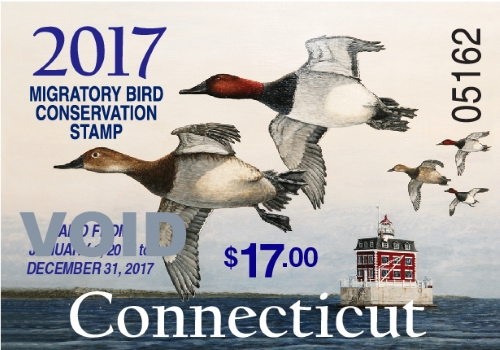Press Releases

11/21/2017
Protect Connecticut’s Cherished Wildlife Habitat - Purchase a Connecticut Migratory Bird Conservation Stamp
The Connecticut Department of Energy and Environmental Protection (DEEP) announced today that Connecticut Migratory Bird Conservation (Duck) Stamps can now be bought through the Online Sportsmen Licensing System (www.ct.gov/deep/SportsmenLicensing) by individuals interested in supporting the conservation and purchase of wetland habitats in Connecticut. Migratory bird hunters are required to purchase a Connecticut stamp to participate in migratory bird hunting seasons. However, other licensed hunters (who participate in other hunting seasons), licensed anglers, and Connecticut residents are encouraged to purchase a Connecticut Migratory Bird Conservation Stamp to provide much needed funding to conserve wetland habitat, thus benefitting a myriad of native fish and wildlife.
“The Connecticut Migratory Bird Conservation Stamp Program is a great example of how conservation works – concerned citizens paying into a program that was formed to protect and enhance vital habitat,” said DEEP Deputy Commissioner Susan Whalen. “By state law, funds generated from the sale of Connecticut Duck Stamps can only be used for the development, management, preservation, conservation, acquisition, purchase, and maintenance of waterfowl habitat and wetlands, as well as the purchase and acquisition of recreational rights or interests relating to migratory birds.”
Previously, non-hunters wishing to purchase a stamp to do their part for wetland conservation in Connecticut had to write to DEEP’s License and Revenue office to request one or more stamps. Now, non-hunters can go to the Online Sportsman’s Licensing System at www.ct.gov/deep/SportsmenLicensing, and under the “Other” category, purchase one or more stamps online for $17 each. Those who are not already licensed hunters or anglers will need to get a Conservation ID number to use the site.
History of Connecticut’s Duck Stamp Program: The Duck Stamp Program was initiated in the early 1990s when concerned sportsmen worked with the DEEP to develop legislation that would generate revenue for wetland conservation. Modeled after the federal Duck Stamp Program, the Connecticut program requires the purchase of a state Duck Stamp, along with a hunting license, to legally hunt waterfowl in the state.
The first Connecticut Duck Stamp debuted in 1993 with a fee of $5.00. From 1993-2002, the sale of Duck Stamps and prints generated over $1.2 million in revenue. Print sales gradually declined over time and the print program was discontinued with the 2002 Duck Stamp. Hunters and conservationists have consistently expressed strong support for the Duck Stamp Program and associated conservation projects. The sale of stamps alone currently generates approximately $50,000 per year. With the return of full-color, artistic Duck Stamps in 2013 through an annual contest, art enthusiasts, stamp collectors, and conservationists are encouraged to purchase as many stamps as they wish to provide funds for wetland conservation projects. Full-color prints may also be available at the discretion of the winning artist.
“The Connecticut Migratory Bird Conservation Stamp is more than just a ‘duck’ stamp because the conservation work it funds provides habitat for a multitude of other wildlife species, like herons, egrets, fish, and amphibians, along with several species of greatest conservation need that are identified in Connecticut’s Wildlife Action Plan,” added Whalen.
Benefits of the Connecticut Migratory Bird Conservation Stamp Program:
- Funds generated through the Migratory Bird Conservation Stamp Program have been responsible for restoring and enhancing over 3,545 acres of critical wetlands. Projects have encompassed nearly 50 sites, mostly on state-owned wildlife management areas. This has benefitted many of the approximately 274 birds, fish, amphibians, and reptiles of the state that rely upon clean, healthy wetlands. In many instances, Duck Stamp funds were the only source of money for these projects.
- Specialized large equipment was purchased to conduct extensive marsh restoration work, particularly along the coast.
- Connecticut was the first state in the nation to establish a unit dedicated to wetland restoration. The DEEP’s Wetland Restoration Unit receives no state funds and operates solely off of outside monies and Connecticut Duck Stamp funds.
- A 75-acre addition to the Wangunk Meadows Wildlife Management Area in Portland was purchased.
- Duck Stamp funds have generated additional monies for Connecticut through matching grants from federal conservation initiatives. By combining Duck Stamp funds with these additional monies, over $4 million have been available to complete wildlife conservation projects. Thus, Connecticut has received a 4:1 return on Duck Stamp monies.
• The Duck Stamp Program is a prime example of a user fee program that has greatly benefitted not only wildlife, but also the people of Connecticut by improving the health of our local environments.
Do your part for conservation in Connecticut. Buy a Connecticut Migratory Bird Conservation Stamp and contribute to habitat protection and restoration.

2017 Connecticut Migratory Bird Conservation Stamp, featuring canvasbacks on the Thames River and painted by Mark Thone.
- Twitter: @CTDEEPNews
- Facebook: DEEP on Facebook

